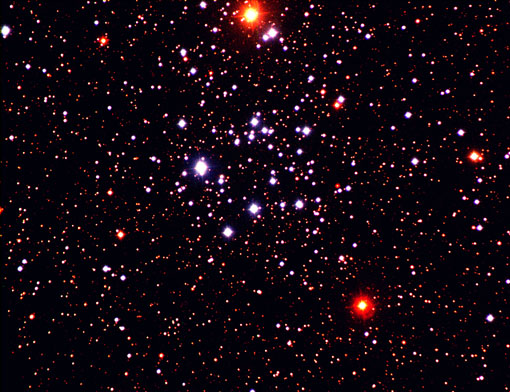

Open Cluster M 50 (NGC 2323)
| Date: | 23./25.10.1995 (B&I/V)
| Time: | 2:25 UT (B,I), 2:50 UT (V)
| Exposure: | B:42m, V:8m, I:4m
|
| Field of View: | 20' x 15'
| Receiver: | WWFPP, 20482 CCD
| Filter: | B,V,I
|
| Instrument: |
1.23m
| Observatory: |
Calar Alto
| Observer: | T. Credner, S. Kohle
|
© Copyright by the observers

Astronomical Institutes of the University of Bonn
From Colors to Astrophysics:
How this three color image
can be interpreted in astrophysics.
The presence of the bright blue stars shows, that this Open Cluster
has a young age, because this massive, hot and short living stars are still
existing. On the other hand there are already some bright red stars, which
seem to be evolved Red Giants (with the assumption, that they are really
cluster members!). So a minimum age of the cluster is given.
Another interesting aspect of this image is, that all the faint stars
appear red. Partly this is due to the general tendency of the main branch
in the Color-Magnitude-Diagram, that means the faint stars are low mass
objects, cool and red. But M 50 is positioned directly in the plane of
our galaxy, so we expect most faint stars not to be cluster members. They
just appear faint, because of their larger distances. And due to the color
dependent extinction in the interstellar dust, that means the blue part
of the spectrum is scattered out much more than the red part, they appear
red. So this image also shows, that you can reach much deeper into the
inner center of our galaxy in the infrared part of the spectrum.
This image is already published in:
Sterne und Weltraum [1/2000]
IBM
Research Page, October 1997, about fractal theory and stellar mass
functions (B. Elmegreen).
Astronomy
Picture of the Day, January 28, 1997,
NASA
Till Credners Diploma Thesis, 1996, University Bonn
M50 page
of Hartmut Frommert
